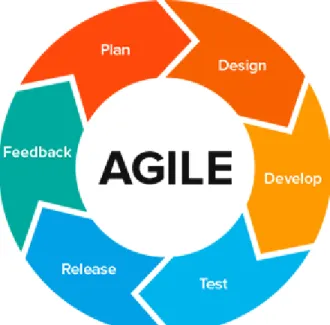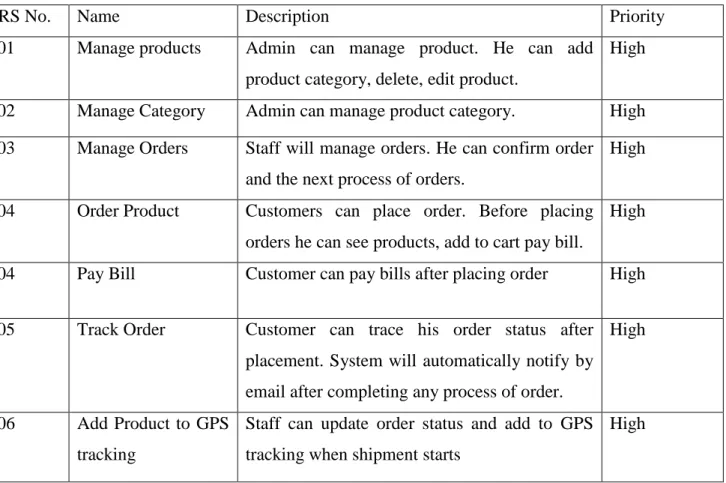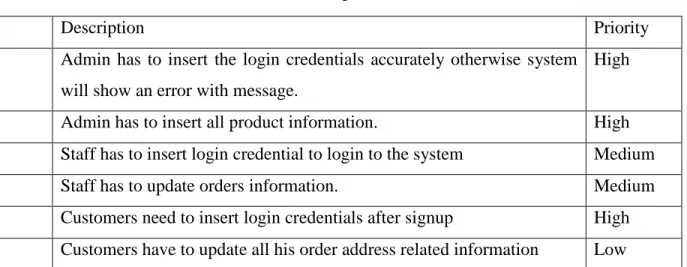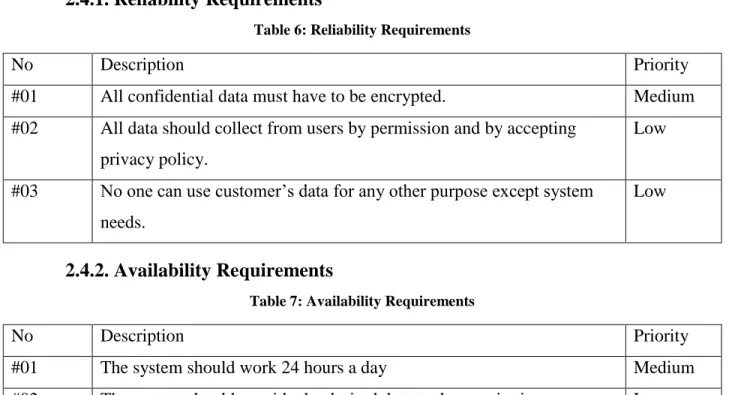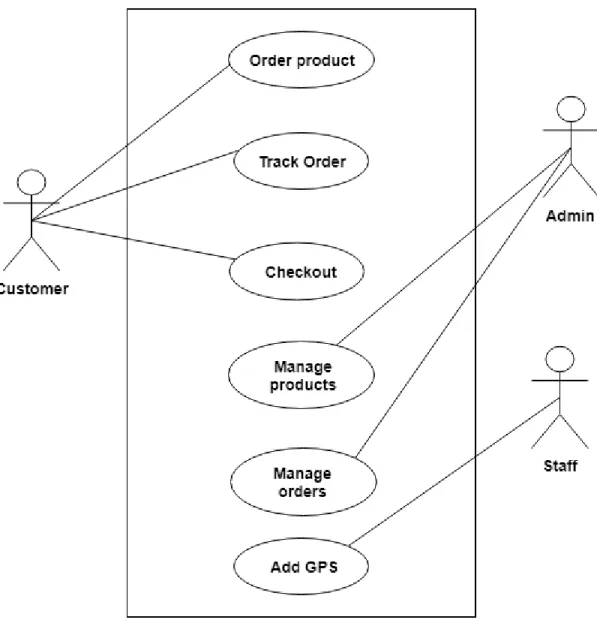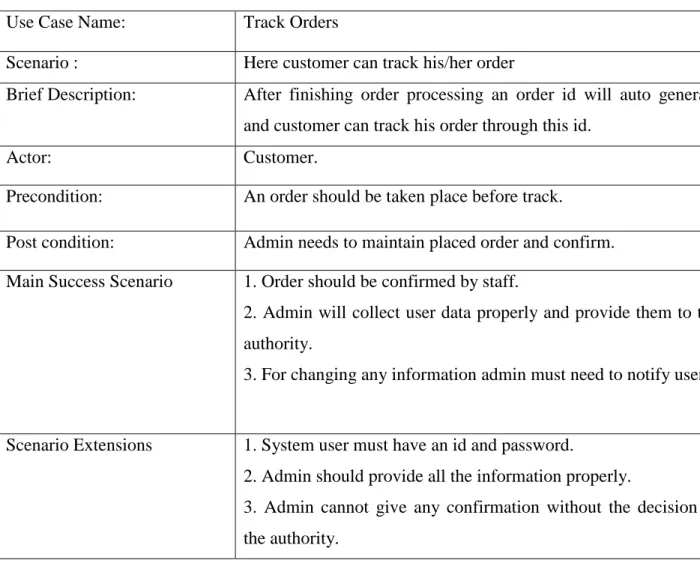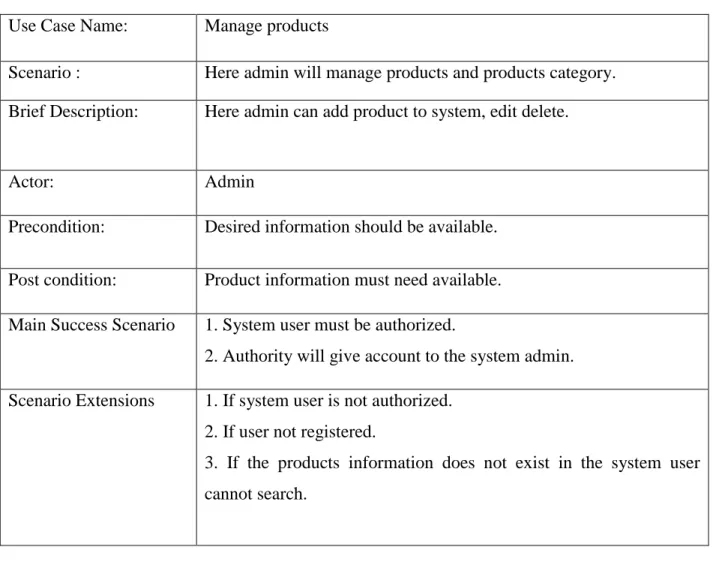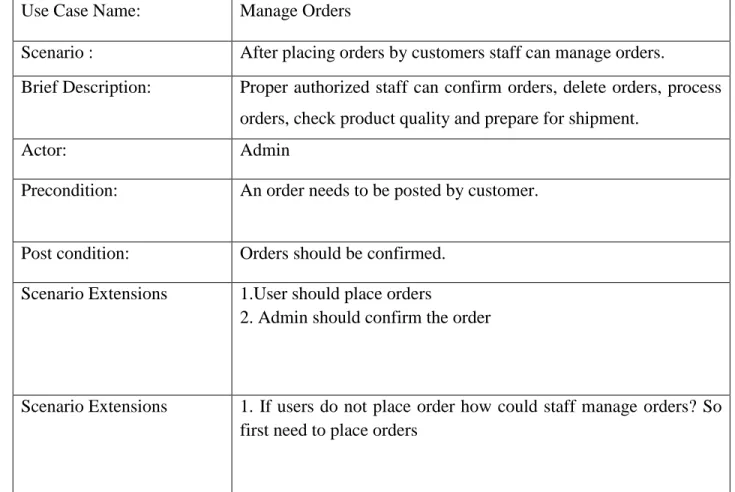Ecommerce Order Tracking System
Submitted By
A.U.M. Tuhin ID: 151-35-892
Batch: 16th
Department of Software Engineering Daffodil International University
Supervised By
Md. Anwar Hossen Senior Lecturer
Department of Software Engineering Daffodil International University
Department of Software Engineering
Daffodil International University
Acknowledgement
First of all, I am grateful to the Almighty Allah for making me eligible to complete this project.
Then I would like to thank my supervisor Md. Anwar Hossen, Senior Lecturer, Department Of Software Engineering. I am extremely grateful and indebted to him for his expert, sincere and valuable guidance and encouragement extended to me.
Beside my supervisor, I would like to express my sincere thanks to Dr. Touhid Bhuiyan, Professor and Head of Software Engineering Department for his constant encouragement.
I would like to thank them who were helped in my project by their very important suggestions without their passionate participation and input; the project could not be successfully conducted.
I take this opportunity to record my sincere thanks to all the faculty members of the Department of Software Engineering for their help and encouragement.
Last but not least, I would like to thank our parents, for their unconditional support, love and without this we would not have come this far.
Executive Summary
E-commerce order tracking system (EOTS) is a web based application. An order tracking system allows the customer to gain insight into where their order is at any given point in time. From the time an order is placed until it is delivered. That means an order tracking system needs to be able to follow and provide insight into the status of the order through its entire journey in the Google map to the customer until it reaches to customer door.
The application is basically for e-commerce Company and the customers. The application provides a full e-commerce website where customers can buy products by fulfilling all the requirements and after purchasing or placing order he/she can be able to track his/her order through the application.
The special feature of this application is google map tracking system. Getting orders from customers e-commerce authority can efficiently handle all the orders through the application at the meantime customers can get notify through email and the application.
The objectives of this project are to make e-commerce business more efficient to customer, increase business profits with customer‟s satisfaction. An order tracking system allows you to improve your customer experience and meet your customers‟ needs for order accuracy throughout the entire ordering, fulfillment, and delivery process.
Table of Contents
Chapter I ... 1
Introduction ... 1
1.1. Project Overview ... 1
1.2. Project Purpose ... 1
1.2.1. Background ... 1
1.2.2. Benefits & Beneficiaries ... 2
Benefits: ... 2
Beneficiaries: ... 2
1.2.3. Goals ... 2
1.3. Stakeholders ... 2
1.4. Proposed System Model ... 3
1.4.1. Agile-Model ... 3
1.5. Project Schedule... 4
1.5.1. Gantt Chart ... 4
1.5.2. HR Planning for Development Phase ... 5
1.5.3. Release Plan ... 5
Chapter II ... 6
Software Requirement Specification ... 6
2.1. Functional Requirements ... 6
2.2. Data Requirements ... 7
2.3. Performance Requirements ... 7
2.3.1. Speed and Latency Requirements ... 7
2.3.2. Precision or Accuracy Requirements ... 7
2.3.3. Capacity Requirements ... 8
2.4. Dependability Requirements ... 8
2.4.1. Reliability Requirements ... 8
2.4.2. Availability Requirements ... 8
2.4.3. Robustness or Fault-Tolerance Requirements ... 9
2.5. Maintainability and Supportability Requirements ... 9
2.5.1. Maintenance Requirements ... 9
2.5.2. Supportability Requirements ... 9
2.5.3. Adaptability Requirements ... 9
2.6. Security Requirements ... 10
2.6.1. Access Requirements ... 10
2.6.2. Integrity Requirements... 10
2.6.3. Privacy Requirements ... 10
2.7. Usability and Human-Interaction Requirements ... 10
2.8. Look and Feel Requirements ... 11
2.8.1. Appearance Requirements ... 11
2.8.1. Style Requirements ... 11
Chapter III ... 12
System Analysis ... 12
3.1. Use Case Diagram... 12
3.2. Use Case Description ... 13
3.2.1. Order Product ... 13
3.2.2. Track Orders ... 14
3.2.2. Manage products ... 15
3.2.3. Manage Orders ... 16
3.3. Activity Diagram ... 18
3.3.1. Activity Diagram for Customer ... 18
3.3.2. Activity for Admin ... 19
3.3.3. Activity for Staff ... 20
Chapter IV ... 21
System Design Specification ... 21
4.1 Sequence Diagram ... 21
4.1.1. Order product, Track Product ... 21
4.1.2. Manage Orders, Add Tracking ... 22
4.1.3. Manage Orders ... 23
4.2. Dataflow Diagram ... 24
4.2.1. DFD Level-0 ... 24
4.2.2. DFD Level-1 ... 25
4.3. ERD Diagram... 26
Chapter V ... 27
User Interface and Manuals ... 27
5.1. User Interface ... 27
5.1.1. Home Page ... 27
5.1.2. Cart ... 28
5.1.3. Sign in Page ... 29
5.1.4. Order Tracking Page ... 30
5.1.5. Order Tracking Page ... 31
5.1.6. Admin Area (Add Product) ... 32
5.1.7. GPS Tracking ... 33
Chapter VI ... 34
Development Tools & Technologies ... 34
6.1. User Interface Technologies ... 34
6.2. Implementation Technologies ... 34
6.2.1. NodeJS (11.3.0) ... 34
6.2.2. NPM (5.7.1) ... 34
6.2.3. ExpressJS (4.16.4) ... 34
6.2.4. MongoDB (4) ... 34
6.2.5. Google Map JavaScript API ... 35
6.3. Platform & Environment... 35
6.3.1. Hardware ... 35
6.3.2. Tools ... 35
6.3.3. Version Control ... 35
Chapter VII ... 36
System Testing ... 36
7.1. Introduction ... 36
7.2. Test Plan Strategy ... 36
7.3. Test Case ... 36
7.3.1. Test Case of Login ... 37
7.3.2. Test Case of Sign Up ... 37
7.3.2. Test Case of Cart ... 38
7.3.3. Test Case of Location Tracking ... 39
7.4. Features yet not tested ... 40
Chapter VIII ... 41
Project Summary ... 41
8.2. Limitations ... 41
8.3. Obstacle & Achievements... 41
8.4. Conclusion ... 41
8.5. Future Work ... 42
Key of Terms ... 43
References ... 44
List of Figure
Figure 1 : Agile-Model ... 3
Figure 2: Gantt chart ... 4
Figure 3: Use Case Diagram ... 12
Figure 4: Activity for customer... 18
Figure 5: Activity diagram for admin and staff ... 19
Figure 6: Activity for staff ... 20
Figure 7: Sequence 1 ... 21
Figure 8: Sequence 2 ... 22
Figure 9: Sequence 3 ... 23
Figure 10: DFD Level-0... 24
Figure 11: DFD Level-1... 25
Figure 12: ERD ... 26
Figure 13: Home Page ... 27
Figure 14: Cart ... 28
Figure 15: Sign in page ... 29
Figure 16: Order Tracking Page ... 30
Figure 17: Order Tracking Page 2 ... 31
Figure 18: Add Product (admin) ... 32
Figure 19: GPS Tracking ... 33
List of Table
Table 1: Functional Requirements ... 6
Table 2: Data requirements ... 7
Table 3 Speed and Latency Requirements ... 7
Table 4: Precision or Accuracy Requirements... 7
Table 5: Capacity Requirements ... 8
Table 6: Reliability Requirements ... 8
Table 7: Availability Requirements ... 8
Table 8: Robustness or Fault-Tolerance Requirements ... 9
Table 9: Maintenance Requirements ... 9
Table 10: Supportability Requirements ... 9
Table 11: Adaptability Requirements ... 9
Table 12: Access Requirements ... 10
Table 13: Integrity Requirements ... 10
Table 14: Privacy Requirements ... 10
Table 15: Appearance Requirements ... 11
Table 16: Style Requirements ... 11
Table 17: Order Product... 13
Table 18: Track Orders ... 14
Table 19: Manage Products ... 15
Table 20: Manage Orders... 16
Table 21: Add tracking ... 17
Table 22: Test case of login ... 37
Table 23: Test case of signup... 38
Table 24: Test case of cart ... 39
Table 25: Test case of location ... 40
Table 26: Features yet not tested ... 40
Chapter I Introduction
1.1. Project Overview
E-commerce order tracking system is a web based application. The application is basically for e- commerce Company and the customers. The application provides a full e-commerce website where customers can buy products by fulfilling all the requirements and after purchasing or placing order he/she can be able to track his/her order through the application.
The special feature of this application is real time google map tracking system. Getting orders from customers e-commerce authority can efficiently handle all the orders through the application at the meantime customers can get notify through email and the application.
After completing all the process of an order and ready for shipment when the delivery man starts delivery or shipment he can start GPS of his mobile phone with the order id and real time location (latitude, longitude) will automatically save to server corresponding to the order id. At the meantime customer will notify the location of his product through a google map in the application customer can able to notify the order information updates and time.
1.2. Project Purpose
1.2.1. Background
E-commerce is increasing rapidly in Bangladesh and it‟s a trend an e-commerce business but the failing rates are also at its revers. There are lots of reasons behind this failing. One of the reasons is they cannot be trustworthy and customers also do not satisfy. Time management is a big fact, after order something from an e-commerce site customers do not know when the order will reach to his hands. That‟s why customers need to inquire again and again by calling to customer support which wastes times and as well as cost.
To reduce this problem and Bangladeshi e-commerce needs e-commerce order tracking system.
1.2.2. Benefits & Beneficiaries Benefits:
Increase customer satisfaction
Do not need to inquire again to customer support center
Reduce costly calls
Increase e-commerce profits holding customers to the website Beneficiaries:
E-commerce customers
E-commerce authority 1.2.3. Goals
Ordering or purchasing something from Bangladeshi e-commerce site there are lot of problem customer are facing some are:
Uncertain order placement‟s time and date.
Need to inquire again and again by calling to know the status of the order
Time wasting
Customers do not return again after purchasing once
The main purpose of this project is to reduce these problems and make e-commerce more reliable, trustworthy and increase customer‟s satisfactions.
1.3. Stakeholders
A stakeholder is a party that has an interest in a company and can either affect or be affected by the business. The primary stakeholders in a typical corporation are its investors, employees, customers and suppliers.
Customers
E-commerce authority
Employees
Shareholders
Suppliers
1.4. Proposed System Model
A software process model is a simplified representation of a software process. Each model represents a process from a specific perspective.
1.4.1. Agile-Model
Our proposed system model is agile model which is an incremental process of software development. Each iteration lasts one to three weeks on average. Engineering actions are carried out by cross functional teams. In software development the term „agile‟ means the ability to respond to changes-changes from requirements, technology and people.
Figure 1 : Agile-Model
1.5. Project Schedule
In project management, a schedule is a listing of project‟s milestones, activities, and deliverables, usually with intended start and finish dates. A schedule is commonly used in the project planning and project portfolio management parts of project management.
1.5.1. Gantt Chart
Weeks
Works
1 2 3 4 5 6 7 8 9 10 11 12
Analysis Phase Feasibility Study Project proposal Project UI
Mid-term defense
Implementation of the project Testing
Document of the project Final defense
Figure 2: Gantt chart
1.5.2. HR Planning for Development Phase 1. Project plan
2. Analysis
3. Requirement gathering
Brainstorming
Interview
Observation
Analysis 4. Design
System design
Database design
System user interface 5. Development
User Module
Event Module
Others 6. Testing
Test plan
Test Case
Test Execution 1.5.3. Release Plan
Release 1: beta version 1.0.0 on 15/10/2018 Release 2: beta version 2.0.0 on 30/10/2018 Release 3: version 3.0.0 on 25/11/2018 Release 4: version 4.0.0 on 04/12/2018
Chapter II
Software Requirement Specification
2.1. Functional Requirements
Table 1: Functional Requirements
SRS No. Name Description Priority
#01 Manage products Admin can manage product. He can add product category, delete, edit product.
High
#02 Manage Category Admin can manage product category. High
#03 Manage Orders Staff will manage orders. He can confirm order and the next process of orders.
High
#04 Order Product Customers can place order. Before placing orders he can see products, add to cart pay bill.
High
#04 Pay Bill Customer can pay bills after placing order High
#05 Track Order Customer can trace his order status after placement. System will automatically notify by email after completing any process of order.
High
#06 Add Product to GPS tracking
Staff can update order status and add to GPS tracking when shipment starts
High
2.2. Data Requirements
Table 2: Data requirements
No Description Priority
#01 Admin has to insert the login credentials accurately otherwise system will show an error with message.
High
#02 Admin has to insert all product information. High
#03 Staff has to insert login credential to login to the system Medium
#04 Staff has to update orders information. Medium
#05 Customers need to insert login credentials after signup High
#06 Customers have to update all his order address related information Low
2.3. Performance Requirements
2.3.1. Speed and Latency Requirements
Table 3 Speed and Latency Requirements
No Description Priority
#01 When GPS starts it should send location info to server in real-time Low
#02 The system should update the location in google map without page refreshing.
Low
#03 The system must have a high speed of manipulation data and reply to the user request.
Low
2.3.2. Precision or Accuracy Requirements
Table 4: Precision or Accuracy Requirements
No Description Priority
#01 The input data should be validate when Customer or admin provide data to the system
Medium
#02 All data should be in place accurately where it is associated Medium
#03 Need to validate all the collections of Mongodb database. Medium
2.3.3. Capacity Requirements
Table 5: Capacity Requirements
No Description Priority
#01 The web application size must able to load at hosting site. Medium
#02 The Mlab or Mongodb atlas database size must be able to store the system data
Low
#03 System should support 100k user at the beginning version Low
#04 System should support 1000 request per second. Low
2.4. Dependability Requirements
2.4.1. Reliability RequirementsTable 6: Reliability Requirements
No Description Priority
#01 All confidential data must have to be encrypted. Medium
#02 All data should collect from users by permission and by accepting privacy policy.
Low
#03 No one can use customer‟s data for any other purpose except system needs.
Low
2.4.2. Availability Requirements
Table 7: Availability Requirements
No Description Priority
#01 The system should work 24 hours a day Medium
#02 The system should provide the desired data to the user in time Low
2.4.3. Robustness or Fault-Tolerance Requirements
Table 8: Robustness or Fault-Tolerance Requirements
No Description Priority
#01 If the system has been crashed, it should not be more than an hour. Low
#02 System must be responsible and should be cross browser supported Low
2.5. Maintainability and Supportability Requirements
2.5.1. Maintenance Requirements
Table 9: Maintenance Requirements
No Description Priority
#01 The system maintenance should be quick. Low
2.5.2. Supportability Requirements
Table 10: Supportability Requirements
No Description Priority
#01 The system support latest nodejs and mongodb (mongoose) version. Medium
#02 Should support all the browsers and screen size. Low
#03 Should support latest and popular cloud services. Low
2.5.3. Adaptability Requirements
Table 11: Adaptability Requirements
No Description Priority
#01 The system should adapt all upgrading version and time. Low
#02 New version of system should support latest node modules Low
2.6. Security Requirements
2.6.1. Access Requirements
Table 12: Access Requirements
No Description Priority
#01 All the users access have to be limited with their use case boundaries Low
#02 Users need to be authorized first to access data. Medium
#03 Only SEQURITY Administrator will be able to enter the system to make maintenance.
Low
#04 Customer‟s boundaries should be within the browser. Low
2.6.2. Integrity Requirements
Table 13: Integrity Requirements
No Description Priority
#01 Only authorized user can add or delete data with their respective accessibility and authorization.
Low
#02 Only admin can delete products and orders information. Medium
2.6.3. Privacy Requirements
Table 14: Privacy Requirements
No Description Priority
#01 The user data must not be visible for public High
#02 The user data should not contain any private issues Medium
#03 All the confidential data should be encrypted. Medium
2.7. Usability and Human-Interaction Requirements
No visible usability and Human-Interaction requirements.
2.8. Look and Feel Requirements
2.8.1. Appearance Requirements
Table 15: Appearance Requirements
No Description Priority
#01 The user interface must be attractive. High
#02 The user interface must be user friendly. Medium
#03 The user interface must be user interactive. Medium
2.8.1. Style Requirements
Table 16: Style Requirements
No Description Priority
#01 The interface color should be flat or material. Medium
Chapter III System Analysis
3.1. Use Case Diagram
Figure 3: Use Case Diagram
3.2. Use Case Description
3.2.1. Order Product
E-commerce Customer Reorder-Cart Management. From this location, customers can add or remove items from their cart, adjust the quantity, or continue shopping on your e-commerce website to add more products to their order. E-commerce websites make the Customer Reorder function very easy for your customers.
Table 17: Order Product
Use Case Name: Order product
Scenario : Customer can browse product select and order.
Brief Description: Customer chose product which he want to buy then add the product to cart and then order the product with proper payment method
Actor: Customer
Precondition: Customer has to sign up or login and products must be available in the system
Post condition: Customer must chose a proper payment method Main Success Scenario 1. Products must be available
2. Products have to be added to system.
3. After adding product to cart customer can order.
Scenario Extensions 1. If there is no products customer cannot add cart and order product.
2. Proper payment selection must be needed either cannot order product.
3.2.2. Track Orders
Registered user can track their order through order id and he/she can see his order status with date and time and he/she can watch his/her product in Google map if the shipment has been start.
Table 18: Track Orders
Use Case Name: Track Orders
Scenario : Here customer can track his/her order
Brief Description: After finishing order processing an order id will auto generate and customer can track his order through this id.
Actor: Customer.
Precondition: An order should be taken place before track.
Post condition: Admin needs to maintain placed order and confirm.
Main Success Scenario 1. Order should be confirmed by staff.
2. Admin will collect user data properly and provide them to the authority.
3. For changing any information admin must need to notify users.
Scenario Extensions 1. System user must have an id and password.
2. Admin should provide all the information properly.
3. Admin cannot give any confirmation without the decision of the authority.
3.2.2. Manage products
System admin can change any setting through valid username and password either he cannot. He should be login authentic way either he cannot. Whenever he changes any setting he should give password again to make final change either not possible.
Table 19: Manage Products
Use Case Name: Manage products
Scenario : Here admin will manage products and products category.
Brief Description: Here admin can add product to system, edit delete.
Actor: Admin
Precondition: Desired information should be available.
Post condition: Product information must need available.
Main Success Scenario 1. System user must be authorized.
2. Authority will give account to the system admin.
Scenario Extensions 1. If system user is not authorized.
2. If user not registered.
3. If the products information does not exist in the system user cannot search.
3.2.3. Manage Orders
Staff can manage orders which are taken place by customers. They can confirm orders, delete orders if order seems fake, process orders, check product quality and finally prepare for the shipment. Delivery men then add the product to tracking system and deliver it to customer.
Table 20: Manage Orders
Use Case Name: Manage Orders
Scenario : After placing orders by customers staff can manage orders.
Brief Description: Proper authorized staff can confirm orders, delete orders, process orders, check product quality and prepare for shipment.
Actor: Admin
Precondition: An order needs to be posted by customer.
Post condition: Orders should be confirmed.
Scenario Extensions 1.User should place orders
2. Admin should confirm the order
Scenario Extensions 1. If users do not place order how could staff manage orders? So first need to place orders
3.2.4. Add product to tracking
After finishing orders management process delivery man adds the product to tracking system so that customer can see the product current status and observe it in Google map.
Table 21: Add tracking
Use Case Name:
Add tracking
Scenario : Here staffs can add product to tracking system.
Brief Description:
Here staff will add product to tracking. Then authority will manage those applications.
Actor: Staff
Precondition: Orders must need to processed and prepare for shipment.
Post condition: GPS and location accuracy must be turn on.
1. Staff needs to register.
2. Orders should be confirmed, processed, checked and ready form shipment.
3. Then staff add the product according to its id in tracking system
Scenario Extensions
If staff not authorized.
If orders not properly place
3.3. Activity Diagram
3.3.1. Activity Diagram for Customer
Figure 4: Activity for customer
3.3.2. Activity for Admin
Figure 5: Activity diagram for admin and staff
3.3.3. Activity for Staff
Figure 6: Activity for staff
Chapter IV
System Design Specification
4.1 Sequence Diagram
4.1.1. Order product, Track Product
Figure 7: Sequence 1
4.1.2. Manage Orders, Add Tracking
Figure 8: Sequence 2
4.1.3. Manage Orders
Figure 9: Sequence 3
4.2. Dataflow Diagram
4.2.1. DFD Level-0Figure 10: DFD Level-0
4.2.2. DFD Level-1
Figure 11: DFD Level-1
4.3. ERD Diagram
Figure 12: ERD
Chapter V
User Interface and Manuals
5.1. User Interface
5.1.1. Home Page
After visiting the website url, this is home page. Click Shop Now button you will find more products, you can also browsing products by category by clicking Products in top navigation bar. At the top right of the navigation bar there is My Cart, Sign and Signup.
If you are a existing user can you can login to the system.
Figure 13: Home Page
5.1.2. Cart
After choosing products you can find this page. You can update your cart by clicking Plus and Minus sign button you can also clear a product as well as the whole cart simply clicking the Clear Cart button.
If you already login to system you can place a order by clicking the Buy Now button otherwise it redirects to Signin page
Figure 14: Cart
5.1.3. Sign in Page
This is customer login page. Existing customer can easily log in to the system simple giving the credentials in the field of email and password.
Figure 15: Sign in page
5.1.4. Order Tracking Page
This is the order tracking page for customer. Order information will auto update against already an order. Customer will notify if any status updates. Customer
Figure 16: Order Tracking Page
5.1.5. Order Tracking Page
This is also the above remaining page of map and updated time of order.
Figure 17: Order Tracking Page 2
5.1.6. Admin Area (Add Product)
This the admin page after authentication admin can add new product by clicking the Add New Product button, a form will open and admin can insert the products product related details.
Admin also update and delete clicking Edit and Delete button respectively.
Figure 18: Add Product (admin)
5.1.7. GPS Tracking
This is the mobile version page for Staff (delivery man) when shipment starts. After insert an order id delivery man can start location tracking buy clicking Start Tracking button and this page will open. Real time location will auto update against this order.
Figure 19: GPS Tracking
Chapter VI
Development Tools & Technologies
6.1. User Interface Technologies
HTML5, CSS3, JavaScript
JQuery 3.2.1
EJS (expressJS template engine)
Twitter Bootstrap
Font Awesome, Flat Icons
6.2. Implementation Technologies
6.2.1. NodeJS (11.3.0)A JavaScript runtime build with chrome‟s v8 JavaScript engine 6.2.2. NPM (5.7.1)
NPM is the package manager for JavaScript and the world‟s largest software registry.
Discover packages of reusable code and assemble them in powerful new ways.
6.2.3. ExpressJS (4.16.4)
Express.js, or simply Express, is a web application framework for Node.js, released as free and open-source software under the MIT License. It is designed for building web applications and APIs. It has been called the de facto standard server framework for Node.js
6.2.4. MongoDB (4)
MongoDB is a free and open-source cross-platform document-oriented database program.
Classified as a NoSQL database program, MongoDB uses JSON-like documents with schemata. MongoDB is developed by MongoDB Inc., and is published under a combination of the Server Side Public License and the Apache License.
6.2.5. Google Map JavaScript API
Using this API easily can get the real time location of an object and easily able to show the location in google map.
6.3. Platform & Environment
6.3.1. Hardware Processor: Intel Core i3.
RAM: 4GB.
Hard drive: 1TB.
Ubuntu 14.04./ Windows 8.1/Windows 10 6.3.2. Tools
IDE/Editor: Visual Studio Code, Atom, Sublime Text3
Cmder Terminal
Robo 3T MongoDB client
Server: Localhost:3000 6.3.3. Version Control
Git
Github (a web based version control hosting for software project)
Chapter VII System Testing
7.1. Introduction
This is aimed at identifying and correcting error. The major objectives of this activity are to ensure that the process done by the application is correct ad meets the objectives of the organization. Test plan aids in effective and systematic testing of the system and it aims at checking the errors of omission and commission that hinders the realization of the objectives.
7.2. Test Plan Strategy
The importance of the test plan is to show how the system is to be tested and also gives precise procedure to be followed during test plan. The test data is identified, what is being tested and the expected outcome as well as actual input. Test plan is one of the standard documents that should be produced in most software engineering projects. If the project does not have any test plan this means that the system produced is low quality. This may not be acceptable to the user it will not satisfy their needs. The test plan should be written as soon as requirements have been identified.
The system will be tested with sample data to see how it would handle input and output functions as well as extreme data or conditions to determine the system behavior in overloaded situation which will directly slow the system that behaves in failure or extreme situation.
7.3. Test Case
A test case is a set of conditions or variables under which a tester will determine whether a system under test satisfies requirements or works properly. The process of developing test case can help find problems in the requirements or design of an application.
Ensure that logical decisions on their true and false side.
Practice all the logical decisions on their true and false side.
Check equivalent partitions and boundary value within their operations bounds.
Exercise internal data structure to assure their validity.
7.3.1. Test Case of Login
Test Case #01 Test Case Name: Testing the login panel.
System: EOTS Subsystem: Login
Designed By: A.U.M. Tuhin Design date: 25.11.18
Executed By: A.U.M. Tuhin Execute Date:25.11.18
Short Description: This field handle's the login functionality of the website.
Precondition: Go to http://localhost:3000/signin.
Table 22: Test case of login
Steps Action Action Result Expected System Response Pass/Fail
01 Enter valid email and valid password
Get logged in. Logged in into the system. Pass 02 Valid email and invalid
password
Not logged in and error message.
Not logged in and error message.
Pass
03 Click login without any data
Required message
Required message Fail
7.3.2. Test Case of Sign Up
Test Case #01 Test Case Name: Testing the signup panel.
System: EOTS Subsystem: Login
Designed By: A.U.M. Tuhin Design date: 26.11.18
Executed By: A.U.M. Tuhin Execute Date:26.11.18
Short Description: This field handle's the login functionality of the website.
Precondition: Go to http://localhost:3000/signup.
Table 23: Test case of signup
Steps Action Action Result Expected System Response Pass/Fail
01 Click sign up without any data
Required message
Required message Pass
02 Click sign up partially filling with data
Not signed up and required messages.
Not signed up and required messages.
Pass
03 Click sign up with valid data and password less than 6 characters.
Signed up in and error message.
No Required message Fail
04 Click sign up with valid data and password not matching with confirm password.
Not signed up in and error
message.
Not signed up in and error message.
Pass
05 Click sign up with valid data and password.
Signed up and redirected to main landing page.
Signed up and redirected to main landing page.
Pass
7.3.2. Test Case of Cart
Test Case #01 Test Case Name: Testing the cart panel.
System: EOTS Subsystem: Login
Designed By: A.U.M. Tuhin Design date: 26.11.18
Executed By: A.U.M. Tuhin Execute Date:26.11.18
Short Description: This field handle's the login functionality of the website.
Precondition: Go to http://localhost:3000/cart.
Table 24: Test case of cart
Steps Action Action Result Expected System Response Pass/Fail
01 Click add to cart on products.
One product is added in cart
For registered user cart is stored in database.
For guest cart is stored in session.
One product is added in cart.
For registered user cart is stored in database.
For guest cart is stored in session.
Pass
02 Increase/decrease cart item
Cart is updated accordingly
Cart is updated accordingly with price.
Pass 03 Remove an item from
cart
Product is not removed.
Product is not removed Fail
7.3.3. Test Case of Location Tracking
Test Case #01 Test Case Name: Testing the tracking panel.
System: EOTS Subsystem: Login
Designed By: A.U.M. Tuhin Design date: 26.11.18
Executed By: A.U.M. Tuhin Execute Date:26.11.18
Short Description: This field handle's the login functionality of the website.
Precondition: Go to http://localhost:3000/cart.
Table 25: Test case of location
Steps Action Action Result Expected System Response Pass/Fail
01 Add GPS tracking with order id.
Start tracking Start tracking Pass
02 Get latitude and longitude
Get two point Get two point Pass
03 Response back to client side of two point
Cannot get Get successfully Fail
7.4. Features yet not tested
Table 26: Features yet not tested
No Name Users
01 Manage Orders Admin
02 Manage Category Admin
03 Barcode code generation System/ Admin
04 Print order report System/ Admin
Chapter VIII Project Summary
8.1. GitHub Link
https://github.com/aumtuhin/final-project
8.2. Limitations
The system is only for Bangladeshi ecommerce perspective.
The system does not able to track international ecommerce orders.
The system needs high speed mobile internet.
8.3. Obstacle & Achievements
Obstacle:
Learning new technology and environment
Limited time and budget Achievements
Learnt new technology
Successfully build a project for production level
8.4. Conclusion
Despite the hardship s encountered in the entire development process the system has been developed for Ecommerce order tracking system thus enabling it improves its efficiency and effectiveness. Maintenance and usage of the system will be easy as the document and user manual of the system will be available to all users. Also there will be room for enhancement as this was considered during development. The system will offer better usability for users to buy products and share their thoughts about these product and process.
8.5. Future Work
Though the system was developed as fine but the future work will include some more major changes. Payment gateway will be integrated real time communication media like chat, notification will be introduced.
Key of Terms
A
Abstract
Acknowledgement Approval
Associate Review Analysis
H
Hardware and Software Specification Html5
C
Conclusion Class Diagram Context Diagram
I
Implementation Introduction
D
Definition and abbreviations Design map
Database Name
J
JavaScript JQuery
E
E-commerce Entity Relationship Diagram
S
System description
Software Requirement Specification Software Development Plan
System Design System Overview System Scope
Software Specification
F
Future work
Functional Requirements
T
Testing Test case Tools
Technical Description
U
Use case diagrams
N
Non-Functional requirements
References
[1].How Much more traffic should you actually getting,” Available: https://neilpatel.com/blog/e- commerce-store-should-be-tracking/. [Accessed: 1-December-2018].
[2].Canada Post, Why provide ecommerce tracking info to customers, available:
https://www.canadapost.ca/web/en/blogs/business/details.page?article=2014/03/12/part_1.
[Accessed: 25- November-2018].
[3]. Wikipedia, “Project Management,” [Online]. Available:
https://en.wikipedia.org/wiki/Schedule_(project_management).[Accessed: 25-November-2018].
[4]. K. Waters, “All About Agile,” All About Agile Agile Development Cycle Comments, 04- December-2011. [Online]. Available: http://www.allaboutagile.com/agile-development-cycle/.
[Accessed: 4-December-2018].
[5]. I. Somerville, Software engineering. Boston: Pearson Education Limited, 2018. [Accessed:
05- December-2018].
[6]. I. Somerville, Software engineering. Boston: Pearson Education Limited, 2016. [Accessed:
05- December-2018].
[7]. Is4profit, Order tracking for business, available: http://is4profit.com/order-tracking/2018.
[Accessed: 05- December-2018].
